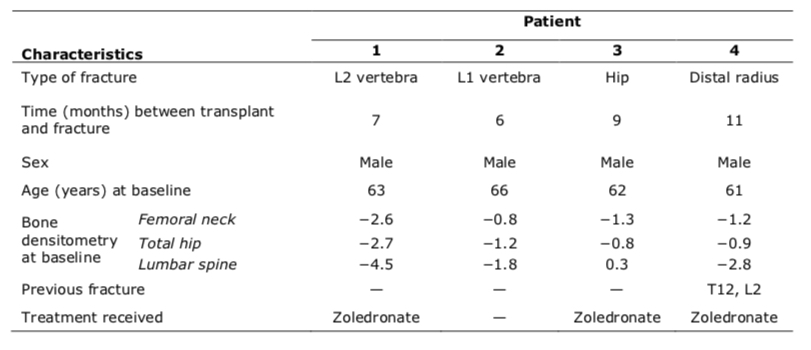Session Information
Date: Tuesday, November 14, 2023
Title: (1996–2018) Osteoporosis & Metabolic Bone Disease – Basic & Clinical Science Poster
Session Type: Poster Session C
Session Time: 9:00AM-11:00AM
Background/Purpose: In solid organ transplantation, liver transplants are among those most frequently associated with the development of low bone mass, which occurs in up to 85% of patients. The estimated incidence of fractures in the post-transplant period, especially in the first six months, ranges from 17% to 65%. However, this can drop to as low as 3.5% after establishing a fracture prevention protocol. In 2019, our center developed an action plan for preventing osteoporotic fractures in the post-transplant period. In a previous report, we observed that 77.3% of liver transplant recipients were candidates to start anti-osteoporosis treatment at the baseline evaluation.
The aim is to estimate the incidence of clinical fragility fractures in patients included in the pre-liver transplant study one year after the baseline evaluation of their bone health.
Methods: In this prospective cohort study, the incidence of clinical fragility fractures was analyzed one year after a multidisciplinary pre-liver transplant assessment in a tertiary academic center in Spain. The study included patients who underwent an initial study from February 2019 to December 2021, underwent liver transplantation and had complete follow-up at one year. The indication for anti-osteoporotic treatment at baseline was defined as bone densitometry with a T SCORE value of less than −1, vertebral wedging assessed by X-ray, or fragility fracture. During the annual follow-up visits, patients were examined for clinical fragility fracture. This descriptive study shows the cumulative incidence at one year and its 95% confidence interval (CI).
Results: Of the 162 patients who underwent the initial evaluation, 79 (48.8%) received a liver transplant and had a full follow-up at one year. Three-quarters of the sample were men, with a mean age of 60 years (standard deviation [SD] 7.5) and a mean body mass index (BMI) of 28.24 kg/m2 (SD 4.35). Most (73.4%) were smokers, and 67% were moderate or heavy drinkers. At baseline, 2.5% (n=2) presented a fragility fracture, and 7.6% (n=6) a vertebral fracture as assessed by X-ray. Half (50.6%, n=40) presented osteopenia, and 21.5% (n=17) osteoporosis. Anti-osteoporosis therapy was indicated in 74.7% (n=59) and administered in 69.7% (n=55), consisting of bisphosphonates (92.7%) or denosumab (7.3%). Of the total liver transplant recipients with follow-up at one year, 4 experienced a clinical fracture (cumulative incidence 5%, 95% CI 1.9-12.3%; Table 1).
Conclusion: After establishing a protocol for preventing fractures in patients who are candidates for liver transplantation, the rate of post-transplant fractures was lower than in the historical series and comparable to another series with pre-transplant care.
To cite this abstract in AMA style:
Rodríguez-Alvear C, López-González M, Perea-Martínez E, Avilés-Hernández A, Calabuig-Sais I, Peral-Garrido M, Bernabeu-Gonzálvez P, Martínez-Sanchís A, Esteve-Vives J, VELA P, Miralles Maciá C, Jovani V, Andrés M. One-year Incidence of Clinical Fragility Fractures After Implementing an Osteoporosis Care Protocol in Patients Eligible for Liver Transplantation [abstract]. Arthritis Rheumatol. 2023; 75 (suppl 9). https://acrabstracts.org/abstract/one-year-incidence-of-clinical-fragility-fractures-after-implementing-an-osteoporosis-care-protocol-in-patients-eligible-for-liver-transplantation/. Accessed .« Back to ACR Convergence 2023
ACR Meeting Abstracts - https://acrabstracts.org/abstract/one-year-incidence-of-clinical-fragility-fractures-after-implementing-an-osteoporosis-care-protocol-in-patients-eligible-for-liver-transplantation/

